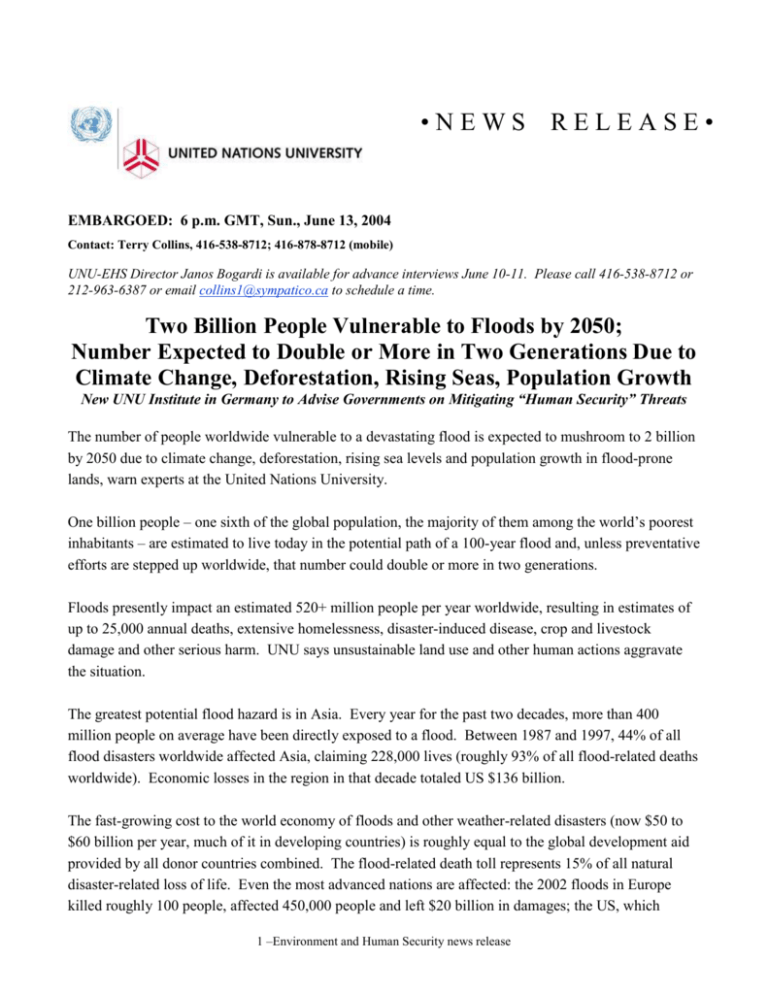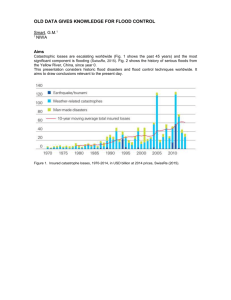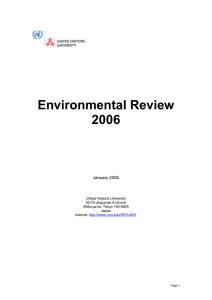Two Billion People Vulnerable to Floods by 2050
advertisement

•NEWS RELEASE• EMBARGOED: 6 p.m. GMT, Sun., June 13, 2004 Contact: Terry Collins, 416-538-8712; 416-878-8712 (mobile) UNU-EHS Director Janos Bogardi is available for advance interviews June 10-11. Please call 416-538-8712 or 212-963-6387 or email collins1@sympatico.ca to schedule a time. Two Billion People Vulnerable to Floods by 2050; Number Expected to Double or More in Two Generations Due to Climate Change, Deforestation, Rising Seas, Population Growth New UNU Institute in Germany to Advise Governments on Mitigating “Human Security” Threats The number of people worldwide vulnerable to a devastating flood is expected to mushroom to 2 billion by 2050 due to climate change, deforestation, rising sea levels and population growth in flood-prone lands, warn experts at the United Nations University. One billion people – one sixth of the global population, the majority of them among the world’s poorest inhabitants – are estimated to live today in the potential path of a 100-year flood and, unless preventative efforts are stepped up worldwide, that number could double or more in two generations. Floods presently impact an estimated 520+ million people per year worldwide, resulting in estimates of up to 25,000 annual deaths, extensive homelessness, disaster-induced disease, crop and livestock damage and other serious harm. UNU says unsustainable land use and other human actions aggravate the situation. The greatest potential flood hazard is in Asia. Every year for the past two decades, more than 400 million people on average have been directly exposed to a flood. Between 1987 and 1997, 44% of all flood disasters worldwide affected Asia, claiming 228,000 lives (roughly 93% of all flood-related deaths worldwide). Economic losses in the region in that decade totaled US $136 billion. The fast-growing cost to the world economy of floods and other weather-related disasters (now $50 to $60 billion per year, much of it in developing countries) is roughly equal to the global development aid provided by all donor countries combined. The flood-related death toll represents 15% of all natural disaster-related loss of life. Even the most advanced nations are affected: the 2002 floods in Europe killed roughly 100 people, affected 450,000 people and left $20 billion in damages; the US, which 1 –Environment and Human Security news release suffered 50 deaths and $50 billion in damage in the Mississippi River flood of 1993, has averaged 25 flood deaths annually since the 1980s. UNU estimates that the number of people living in flood-prone areas will roughly double due to: more extreme weather systems that accompany global climate change, rising sea levels; and continuing deforestation, especially in mountain regions. It also predicts that pressure to live and work in flood-prone areas, which typically feature attractive rich soils, abundant water supplies and ease of transport, will increase as the world’s population continues spiraling upward – to a projected 10 billion by 2050. The warning was issued as UNU officially opens a new institute in Bonn, Germany June 15 dedicated to study of the Environment and Human Security (UNU-EHS), strengthening the capacity of governments to respond to natural disasters, and establishing sustainable land management practices. “The growing frequency and magnitude of extreme environmental events worldwide has intensified research interest in natural disasters as well as regional vulnerability and response capabilities,” says Dr. Janos Bogardi, founding director of UNU-EHS. “In the warmer, wetter world predicted by science today, the northern part of the Northern Hemisphere will likely see more storms while some continental areas might have drier summers and more risk of drought. Sea levels could rise, fed in part by melt-water from glaciers and ice caps. Along with this, extreme high-water levels may occur with increasing frequency. Higher sea levels could inundate small islands, flood coastal lowlands, and erode sand dunes. “Most urgently needed to adapt to the growing risk of flood disasters is greater global capacity to monitor and forecast extreme events,” Dr. Bogardi says. “Armed with better information, superior early warning systems and infrastructure can be installed, and new planning strategies devised.” “It is also necessary to ensure that increasingly freakish climate variability and the gradual forces of climatic change and deforestation are factored into the total picture,” he says. There needs to be a shift in the international mindset – from reaction and charity to anticipation and preemption, Dr. Bogardi adds. Countries are typically generous with post-disaster relief but less so when it comes to pre-disaster preparedness, spending $100 in relief for every $1 in preparedness. 2 –Environment and Human Security news release Recent studies have also shown the cost of constructing disaster-resistant buildings adds only 2 to 12 per cent on average to the final costs. Meanwhile forecasting and warning systems commonly show a costbenefit ratio of 10 or 15 to 1. Mortality is often highest in rural areas of poor countries where disaster preparedness and early warning is virtually non-existent and where health coverage is usually weak or not easily accessible. In such areas, people are less likely to evacuate from flood prone areas – and in some cases fear leaving and potentially losing their possessions or their property claim. “The thousands of tragic casualties from flooding and Haiti and the Dominican Republic in recent weeks underline the extreme vulnerability of developing countries,” Dr. Bogardi said. “While economic losses due to natural disasters destroy resources equivalent to 2% of GDP in developed countries, in developing countries, the proportion can reach as high as 13% of GDP. Unsustainable practices and the ever increasing disasters they trigger prevent people to break through the brutal cycle of poverty.” Scientists say warming sea temperatures may increase the number of cyclones and storm surges reaching shore. Storm surges can be just as lethal as the weather systems that spawn them – “walls of water” 60 to 80 kilometres across and 2 to 5 metres high that can pour in from the sea with immense force, washing away everything in their path. The most massive storm surge in recent times caused 300,000 deaths in the coastal wetlands of Bangladesh in 1970. Flooding is triggered by such conditions as severe thunderstorms, tornadoes, tropical cyclones and hurricanes, the El Niño effect, monsoons, dam breaks, ice jams or melting snow. These conditions annually cause thousands of deaths through drowning in vehicles and homes, accidents while walking or driving around water, electrocution, roof collapses, lightning strikes and heart attacks, as well as through the elevation of water-related disease. “In view of the ever increasing flood disasters and other threats to human security, there is an urgent need to reassess how we respond and prevent the potential of catastrophic loss of life and economic damage from natural disasters,” says Under Secretary-General Hans van Ginkel, Rector of UNU. “The concept of human security has evolved in recent years. Human security as now defined puts the individual at the center of debate, analysis and policy. It is the individual who is paramount; government is an instrument of the people to protect human life and enhance human welfare,” he says. “Applying this new concept to its work, the UNU-EHS programme will research ways of mitigating environmental threats, shedding new light on the interrelationships between the social, political, economic, technical, and natural factors involved.” 3 –Environment and Human Security news release Addressing the problem from the perspective of human security requires a paradigm shift in thinking towards disaster prevention and preparedness, says Dr. Bogardi. “Instead of starting with the focus on natural hazards and their quantification, the assessment and ranking of the vulnerability of affected groups should serve as the starting point in defining priorities and remedial interventions.” Background: UNU-EHS Supported by the German Federal Ministry of Education and Research and the Ministry of Science and Research of the State of North Rhine-Westphalia, UNU-EHS will initially focus on flood plains and deltas, with emphasis on urban centres. Drought and its impact on rural communities are envisaged as an added priority from 2006. In addition to natural calamities, the Institute will work on ‘creeping’ environmental hazards – including climate change, land degradation, degradation of the social environment, population displacement, and changing resource availability and quality -- which imperil communities in a more gradual but equally detrimental and multifaceted way. UNU-EHS has already initiated or planned joint projects and activities with such organizations as the UN International Strategy for Disaster Reduction (UN/ISDR), the World Meteorological Organization (WMO), the UN Educational Scientific and Cultural Organization (UNESCO), the German Committee for Disaster Reduction (DKKV), the German Weather Service (DWD), the Global Water System Project (ICSU), the Institute for Catastrophic Loss Reduction (ICLR), the Global Fire Monitoring Centre (GFMC) and the Bonn International Centre for Conversion (BICC), and the Centre for Development Research (ZEF). A formal Cooperation Agreement between UNU and the University of Bonn provides a strong link to the local academic community. Established by the U.N. General Assembly in 1973, UNU is an international community of scholars engaged in research, advanced training and the dissemination of knowledge related to pressing global problems. Activities focus mainly on peace and conflict resolution, sustainable development and the use of science and technology to advance human welfare. The University operates a worldwide network of research and post-graduate training centres, with headquarters in Tokyo. 4 –Environment and Human Security news release Appendix: UNDP Flood Disaster Risk Tables 5 –Environment and Human Security news release Source: UN Development Programme: http://www.undp.org/bcpr/disred/rdr/9e%20Disaster%20Risk%20Index%20Tables.pdf 6 –Environment and Human Security news release








